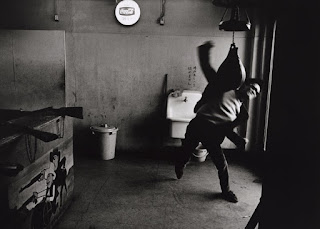PHOTOGRAPHY WRDS &TRMS
 Aesthetics - The qualities that combine to make something look the way it does.
Aesthetics - The qualities that combine to make something look the way it does.I am drawn to this photo because of the black and white color.
Camera Obscura - A blacked out chamber with a small hole through which light gets compressed. First written observation was by Mo Ti, in China, circa 400 BC.

Exposure Triangle:

Aperture- Opening (into the camera)

Shutter: mechanism that allows light to enter the camera for precise periods of time.

Iso: the sensitivity (to light) of the sensor/film

APERTURE:
Aperture and depth of field: Aperture is the size of the opening into camera, and the larger the aperture the smaller sliver focus you will have

Example of a change in aperture:

Iso:
The sensitivity of the camera.

White Balance (Wb):
The temperature of the light being photographed.

HISTORY & ARTISTS
JOSEPH NICEPHORE NIEPCE
Made the world's first photograph in 1827.
The exposure time was approx. EIGHT hours.

View from the window at Le Gras, France. 1827.

FIRST PHOTO OF A PERSON - 1883 by Louis Daguerre (Daguerreotype)
Boulevard du Temple, Paris.
http://mashable.com/2014/11/05/first-photograph-of-a-human/#sisMPxIjigqH
FIRST "SELFIE"
Robert Cornelius. 1839
Amateur Chemist & photography enthusiast.
Philadelphia.

MATHEW BRADY
Civil War Photographer.
1860s
First time the public saw casualties of war printed in their newspapers.
Eadweard Muybridge
1830-1904English
Pioneer in photographing motion.
Created the zoopraxiscope (1879)
"The Gallop"

JULIA MARGARET CAMERON
1815-1879Known for soft focus and 'painterly' quality of her images.
Was panned as not serious enough as a photographer.
Accepted by painters (pre-Raphaelites) more than photographers.
Close-Cropped portraits are inspiration for photographers today.
Edward Curtis
1868-1952
Photographer & ethnologist.
Focused on documenting the American West & Native American people.


JACOB RIIS
1848-1914
Grew up in poverty.
Considered to be a father of photojournalism.
Photographed the tenements/slums of NYC to raise awareness of the plight of the poor.
LEWIS HINE
1874-1940
Photographer & Sociologist.
Used his camera for social change and reform.
Photographed mines, cotton mills & factories to document working children.
His work directly led to children labor laws.
DORTHEA LANGE
1895-1965
Documentary photographer & photojournalist.
Began as a portraitist (in a studio).
During the great depression (1930s), worked for the Farm Securities Administration to document the plight of the poor & forgotten.
During WWII, documented the plight of Japanese citizens who were forced into internment camps. The photos were not seen during the war.
Migrant mother, 1936
HENRI CARTIER-BRESSON
1908-2004
A master of street photography.

Known for the decisive moment = The moment when visual and psychological elements come together in the photo.
ART THEORY &
AESTHETICS:
CONTRAST= The difference between light and dark.
VALUE= The intensity of a color (or the B&W).
HUE= The color.
TINT= Adding white to a hue.
SHADE= Adding black to a hue.
Rule of Thirds-
A compositional theory where the main subject matter is placed in an intersecting point based on a division of thirds vertically and horizontally.
Manuel Álverez Bravo
1902-2002
Pioneer of artistic photography in Mexico.
Most important figure in 20th-century Latin American photography.
Captured the history of Mexican society and culture
Street photography, folk art & rituals, human interaction.






Comments
Post a Comment